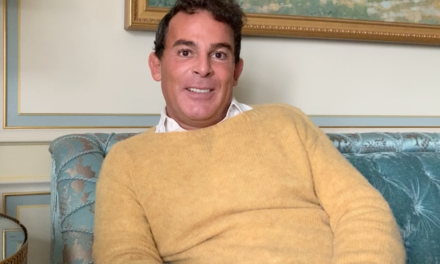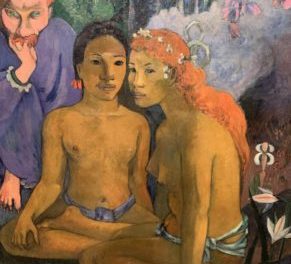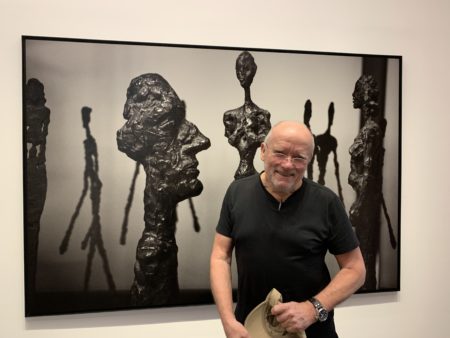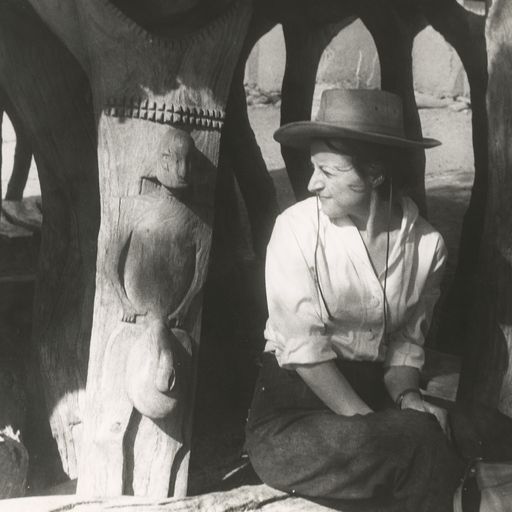
Hélène Leloup
2 kind of dealers
You could say there are two kinds of art dealers. There are the ones who are obsessed with business, and with generating income to support their activities. Generally, they aren’t able to keep their best objects. And then there are the ones who, on the contrary, are obsessed with the impact of their artistic choices and the memory they are going to leave behind.
Beyeler, Berggruen
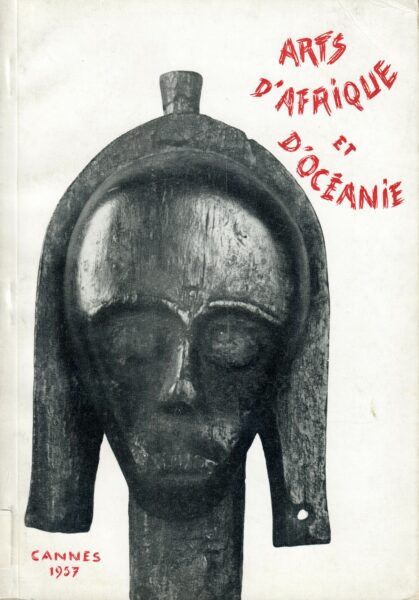
1957 Cannes Exhibition Catalogue
This is the case, for example, of Ernst Beyeler, the famous modern art dealer whose glorious foundation in Basel bears his name. This is also true of Picasso’s last dealer, Heinz Berggruen, whose collection – which has become a global blockbuster – usually housed in Berlin in a museum named after him following a donation in 2000, is currently touring Japan. Heinz Berggruen wrote a book whose title is enlightening: “J’étais mon meilleur client. Souvenir d’un marchand d’art (“I was my own best client. Memoirs of an art dealer” (1)).
First woman
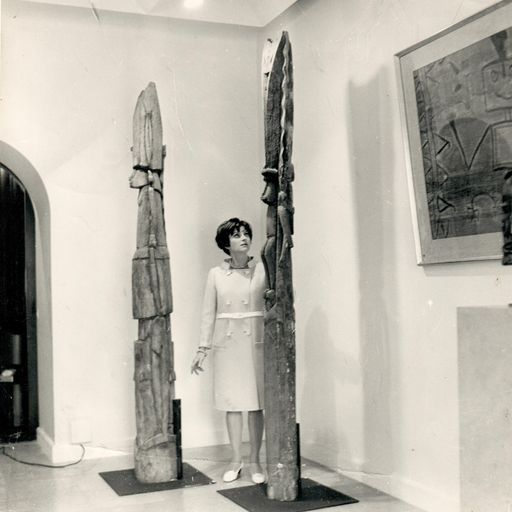
Hélène Leloup
We might imagine that African art dealer Hélène Leloup was her own best client. This French dealer, who was born in 1927 and is now very frail, was a trailblazer in several respects. Firstly because she was the first to trade as a woman in a very male-dominated world. She is famous for having a very strong character, having worked alongside her two successive husbands Henri Kamer and Philippe Leloup in Paris from 1956 and also in New York from 1960, before retiring in 2004.
Africa in 1952
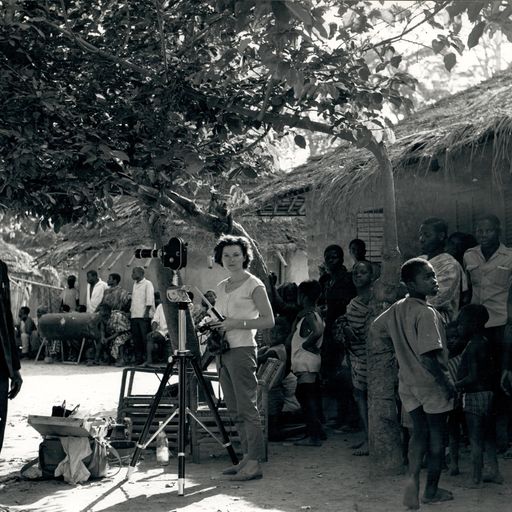
Hélène Leloup
She first visited Africa in 1952: “It was a significant shock. Everything impressed me, everything delighted me: the country, the people, the blue sky, the red earth – and the art” (2). She would also be remembered for several things. “Every great dealer has a particular eye. We even begin to recognize the kinds of objects they choose,” explains Yves Le Fur, former head of the collections at the Musée du Quai Branly-Jacques Chirac. “Hélène Leloup has unfailing taste.”
Androgynous image of a woman-king
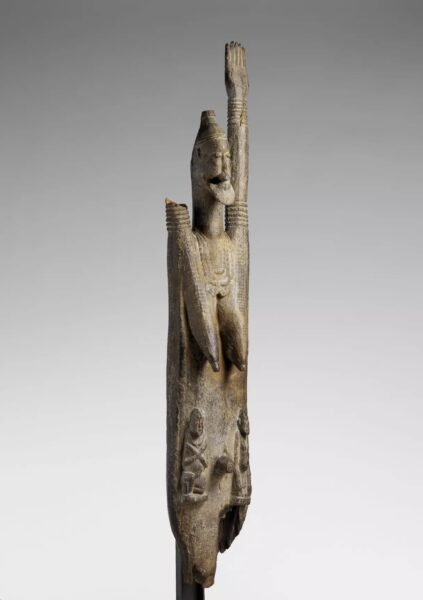
So in 2004, thanks to the Axa sponsorship of 4 million euros and clearly a reduction in the sale price on the part of Hélène Leloup, a statue from the 11th century from the Pre-Dogon Djennenké culture standing 2.1 metres tall entered the collections of the French museum. It depicts the , from the empire of Ghana.
Dogon people
Similarly, in 2011 when the president of the institution, Stéphane Martin, wanted to stage an exhibition on the Dogon people of West Africa, it was Hélène Leloup who he appointed as curator. “She really has been at the origin of the discovery of Dogon art in the West. She has explained this on several occasions: she would buy from dealers in Bamako. But the most important thing to her was familiarity with the artworks. And in this field nothing can replace the fact of having seen a large number of them. She really loved Africa and she even funded a school in Mali.”
Another reading
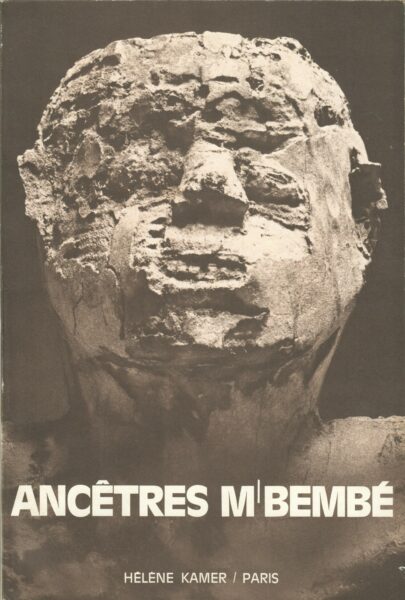
1974 Mbembe Exhibition Catalogue
She would reveal in the 2011 catalogue: “Here I am trying to offer another reading, by replacing sculptures within their historical context in order to explain their differences in age and style (…) All those who have some artistic instinct can appreciate, in sculpture, the beauty of a figure, the power of a body, the momentum of a horse… But by knowing the reason behind this creation, religious or otherwise, its purpose, the era when it was created, the care accorded to it… all of this seems to me to add to its enjoyment.”
Pavillon des Sessions
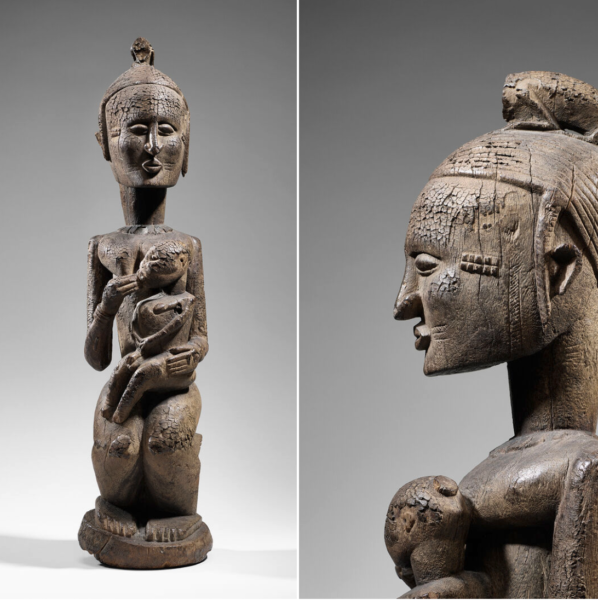
Dation Dogon-Komakan Figure, Mali
Hélène Leloup gave this area of creation the keys for reading comparable to those used in Western art by attempting to identify the authors and date the wooden pieces using the carbon-14 technique, as well as mapping the styles according to region. In 2022, the Musée du Quai Branly announced the arrival in their collections of a wooden Dogon statue from the late 18th century depicting a mother with a child on her lap, measuring 68cm tall. Today it is exhibited in the holy of holies of French “art premiers”, the Pavillon des Sessions at the Louvre, where it was acquired also thanks to a dation made by Hélène Leloup.
20 Million euros
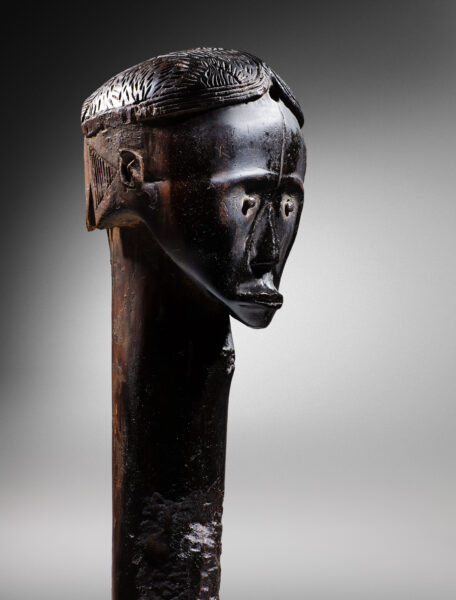
The final stage of this striking itinerary: Sotheby’s has been charged with the task of dispersing on 21 June 2023 in Paris, then in 2024 in New York, a part of her collection, with a total estimate of 20 million euros.

Fang Head of reliquary, Gabon
Helena Rubinstein
The first part includes 56 lots featuring a star piece of a wooden Fang head from Gabon, with an estimate of 4 million euros. This carved figure of a male ancestor is 45cm tall and covered in a glossy patina, and was originally attached to a chest in which relics were kept. On occasion this sacred object would be removed and handled like a puppet by the initiated during certain rituals and covered in oils and resin. The work belonged to one of the most eminent collectors of African Art, Helena Rubinstein. It was also displayed in 2019 at the exhibition dedicated to the cosmetics queen at the Musée du Quai Branly.

Nkonde statue, Kongo
1966
As early as 1966, Hélène Leloup was an expert at the sale of the Helena Rubinstein collection at Park Bernett in New York. “We have traced this exceptional object back to the 1930s. Since 1966 Hélène Leloup has kept this head, which presided over her dining room, without ever wanting to sell it,” explains the Sotheby’s expert Pierre Mollfulleda. Works of this type today belong to a category that is one of the most highly sought after in the niche market of ethnographic art. In 2021, another Fang head from the Périnet collection was auctioned at Sotheby’s in Paris for 7.6 million euros. It belonged to a trailblazer in the collection of African art, the modern painter Maurice de Vlaminck.
Bronze necklace
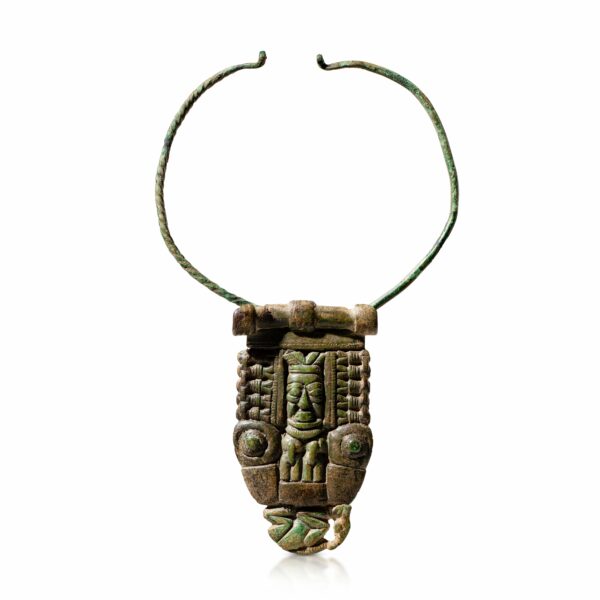
Djennenke Pendant, Mali
The sale doesn’t just feature African objects with estimates in the millions of euros. Among the interesting lots there is also a bronze necklace most likely made for a dignitary from the Dogon Djennenké region (estimate: 30,000 euros). It depicts a male figure with his headdress, surrounded by adornments, which is not unreminiscent of pre-Colombian styles. According to the catalogue she acquired it from Samba Kamissoko, a Bamaki dealer. At a time when questions are being raised around the looting from the colonial period, the documentation amassed very early on by Hélène Leloup about the sources of acquisitions could be an element that adds value.
Metropolitan museum
In the catalogue, another Bamako dealer, Mamadou Keita, states: “Madame Hélène Leloup has entered the Pantheon of Immortals. I’ve cited her in several of my interviews as a Great Protector and a protector above all of the traditional arts of Mali.” In New York, too, the dealer who was based on Madison Avenue made many loans for exhibitions, particularly at the Metropolitan Museum in New York, and sold very early on to figures in the world of film such as John Huston, Billy Wilder, Kirk Douglas and the billionaire Nelson Rockefeller. This is because she was close to Robert Goldwater, the author of seminal works on African art who advised this owner of a large American fortune.
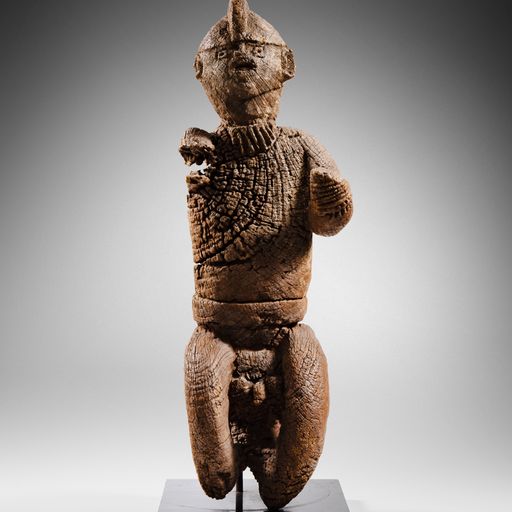
Mbembe Figure, Nigeria
The husband of Louise Bourgeois
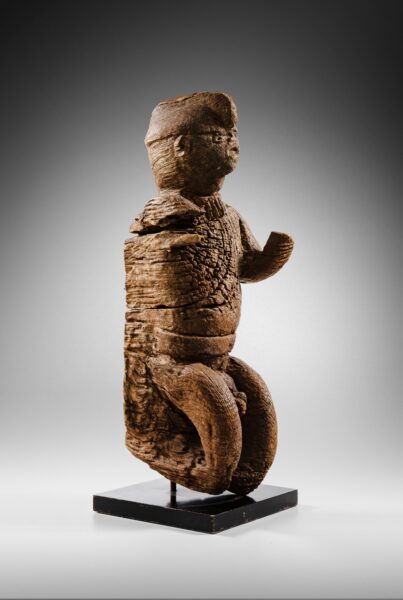
Mbembe Figure, Nigeria
But Robert Goldwater was also the husband of famous French American artist Louise Bourgeois. Which perhaps explains the presence in the Leloup collection of a rare work by the latter dated from 1996. It is of a human skeleton drawn on a large napkin that she has “enriched” with chicken bones in places (estimate: 60,000 euros).
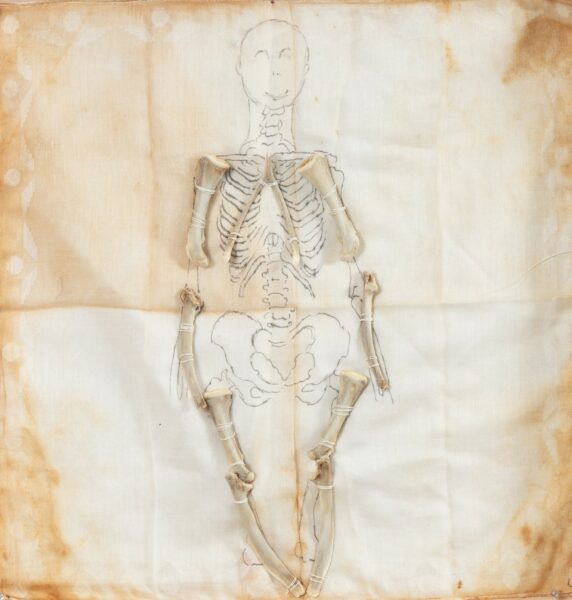
Louise Bourgeois
Francis Bacon
Hélène Leloup was also interested in contemporary art. At the entrance to her apartment you can admire a portrait of a woman made in 1960 by the Irish artist Francis Bacon. It depicts a woman wearing a white shirt with a distorted, twisted face against a black and green background. She acquired it in 1996 for 755,000 dollars. Today it has an estimate of 6 million euros.
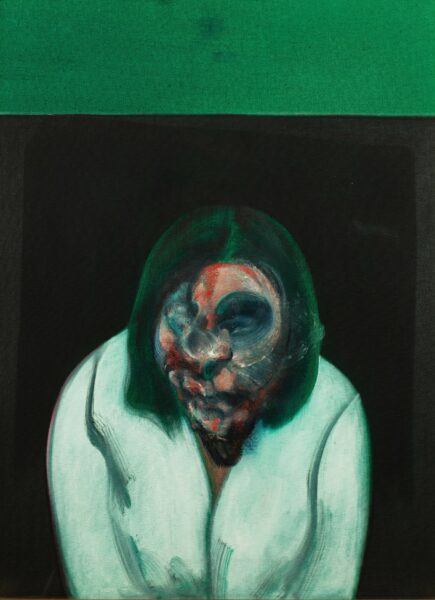
Francis Bacon
(1) L’Arche. 1997.
(2) Le Monde, 3 May 2004. “Hélène Leloup” souvenirs d’Afrique. Emmanuel de Roux.
Support independent news on art.
Your contribution : Make a monthly commitment to support JB Reports or a one off contribution as and when you feel like it. Choose the option that suits you best.
Need to cancel a recurring donation? Please go here.
The donation is considered to be a subscription for a fee set by the donor and for a duration also set by the donor.

